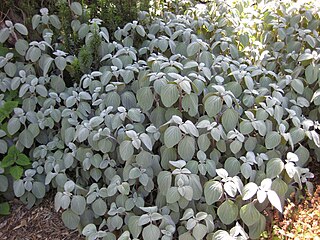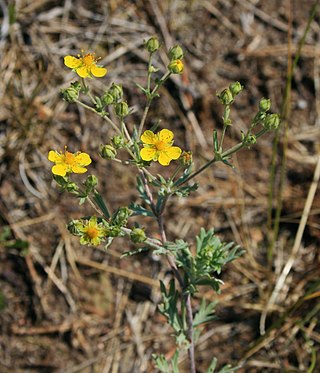
Salvia rosmarinus, commonly known as rosemary, is a shrub with fragrant, evergreen, needle-like leaves and white, pink, purple, or blue flowers, native to the Mediterranean region. Until 2017, it was known by the scientific name Rosmarinus officinalis, now a synonym.

Lunaria annua, commonly called honesty or annual honesty, is a species of flowering plant in the cabbage and mustard family Brassicaceae. It is native to southern Europe, and cultivated throughout the temperate world.

Salvia guaranitica, the anise-scented sage or hummingbird sage, is a species of flowering plant in the sage family, Lamiaceae, native to a wide area of South America, including Brazil, Paraguay, Uruguay, and Argentina. It is cultivated all over the world, and is naturalized in New Zealand and Chile.

Lavandula angustifolia, formerly L. officinalis, is a flowering plant in the family Lamiaceae, native to the Mediterranean. Its common names include lavender, true lavender and English lavender ; also garden lavender, common lavender and narrow-leaved lavender.

Cornus alternifolia is a species of flowering plant in the dogwood family Cornaceae, native to eastern North America, from Newfoundland west to southern Manitoba and Minnesota, and south to northern Florida and Mississippi. It is rare in the southern United States. It is commonly known as green osier, alternate-leaved dogwood, and pagoda dogwood.

Salvia pratensis, the meadow clary or meadow sage, is a species of flowering plant in the family Lamiaceae, native to Europe, western Asia and northern Africa. The Latin specific epithet pratensis means "of meadows", referring to its preferred habitat. It also grows in scrub edges and woodland borders.

Rudbeckia triloba, the browneyed or brown-eyed susan, thin-leaved coneflower or three-leaved coneflower, is a species of flowering plant in the family Asteraceae with numerous, yellow, daisy-like flowers. It is native to the central and eastern United States and is often seen in old fields or along roadsides. It is also cultivated as an ornamental.

Coleus argentatus, synonym Plectranthus argentatus, common name silver spurflower, is a species of flowering plant in the mint family. It is native to rock outcrops and rainforest in the border region of Queensland and New South Wales, Australia. Growing to 1 m (3 ft) tall and broad, it is a spreading deciduous shrub. The hairy leaves are ovate to broad-ovate, 5–11.5 cm long, 3–5.5 cm wide with crenate margins. The hairs give the plant an overall sage green to silvery colour. The flowers are borne on terminal racemes up to 30 cm (12 in) long, and are bluish white.

Salvia greggii, the autumn sage, is a herbaceous perennial plant native to a long, narrow area from southwest Texas, through the Chihuahuan Desert and into the Mexican state of San Luis Potosi, typically growing in rocky soils at elevations from 5,000 to 9,000 ft. It was named and described in 1870 by botanist Asa Gray after Josiah Gregg, a merchant, explorer, naturalist, and author from the American Southwest and Northern Mexico, who found and collected the plant in Texas. It is closely related to, and frequently hybridizes with, Salvia microphylla. Despite the common name "autumn sage", it blooms throughout the summer and autumn.

Stewartia malacodendron, the silky camellia, silky stewartia or Virginia stewartia, is a species of flowering plant in the family Theaceae. It grows slowly into a large deciduous shrub or small tree, typically 3–4.5 m (10–15 ft) tall, but sometimes as tall as 9 m (30 ft). It is native to the southeastern United States.

Salvia fruticosa, or Greek sage, is a perennial herb or sub-shrub native to the eastern Mediterranean, including Southern Italy, the Canary Islands and North Africa. It is especially abundant in Palestine, Israel and Lebanon.

Shepherdia argentea, commonly called silver buffaloberry, bull berry, or thorny buffaloberry, is a species of Shepherdia in the Oleaster family.

Salvia microphylla, the baby sage, Graham's sage, or blackcurrant sage, is an evergreen shrub found in the wild in southeastern Arizona and the mountains of eastern, western, and southern Mexico. It is a very complex species which easily hybridizes, resulting in numerous hybrids and cultivars brought into horticulture since the 1990s. The specific epithet microphylla, from the Greek, means "small leaved". In Mexico it is called mirto de montes, or "myrtle of the mountains".

Salvia confertiflora, the Sabra spike sage, is a species of flowering plant in the family Lamiaceae, native to Brazil. This herbaceous perennial reaches 1–1.5 m (3.3–4.9 ft) in height, and 10–50 cm (3.9–19.7 in) spread in one season, becoming shrubby at the base with age.

Salvia fulgens, the Cardinal sage or Mexican scarlet sage, is a species of flowering plant native to the Mexican mountains adjacent to the state of Puebla, growing at 8,700-11,000 ft elevation. It prefers the edge of oak and coniferous woodlands, especially in clearings of Abies religiosa. The mountains receive fog and rain nearly year-round.

Salvia patens, the gentian sage or spreading sage, is a species of flowering plant in the sage family Lamiaceae that is native to a wide area of central Mexico. This herbaceous perennial was introduced into horticulture in 1838 and popularized a hundred years later by the Irish gardener and botanist William Robinson (1838-1935).

Buddleja fallowiana is a species of flowering plant in the figwort family Scrophulariaceae. It is endemic to the Yunnan province of western China, where it grows in open woodland, along forest edges and watercourses. The plant was collected in China by the Scottish botanist George Forrest in 1906, and named in 1917 by Balfour and Smith for George Fallow, a gardener at the Royal Botanic Garden Edinburgh. Fallow had died in Egypt in 1915 from wounds sustained fighting in the Gallipoli Campaign.

Melaleuca argentea, commonly known as the silver cadjeput, silver-leaved paperbark, silver cajuput, or mardderr in the Kunwinjku language, is a plant in the myrtle family, Myrtaceae and is endemic to northern Australia. It is a common tree along river banks or around swamps in the tropics. It has papery bark and weeping foliage and has been the subject of important scientific research.

Potentilla argentea, known as hoary cinquefoil, silver cinquefoil, silvery cinquefoil, or silver-leaf cinquefoil, is a perennial herb in the family Rosaceae. Potentilla argentea is native to Europe, Asia Minor, and Siberia, and is introduced throughout temperate areas in North America and in New Zealand.
Androcalva argentea is a species of flowering plant in the family Malvaceae and is endemic to Queensland. It is a tall shrub that forms suckers from rhizomes and has silvery branchlets and leaves, the leaves egg-shaped with wavy edges and serrated, and dense clusters of 10 to 30 white to cream-coloured flowers.




















